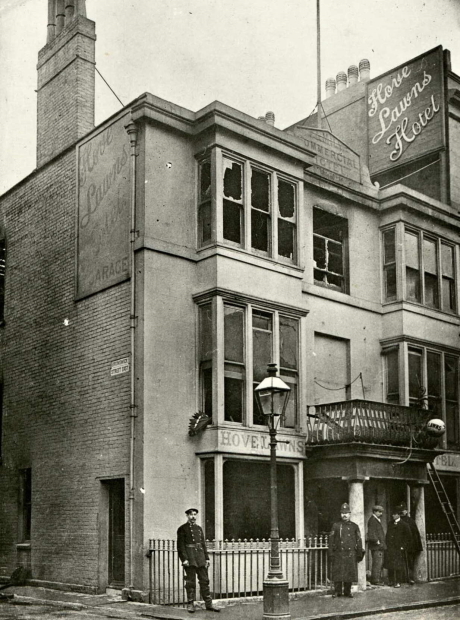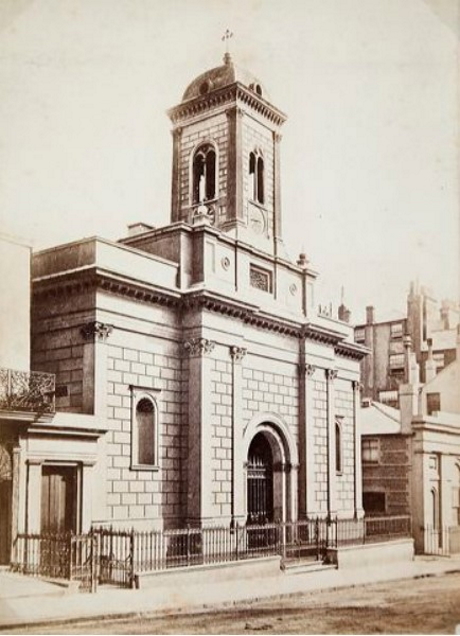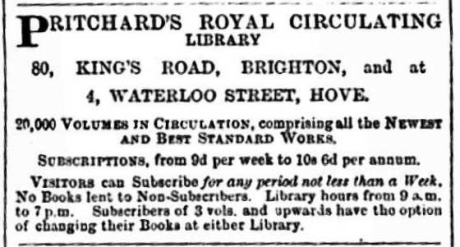4 Waterloo Street
Number 4 is a good example of a house with a varied history in Waterloo Street. It spent much of its early history as a Lodging House like many others in the street and has been the home to other businesses such as a pianoforte warehouse, a library, bookseller and post office and as a private hotel. It is next door to what is now the Southern Belle pub, and which has variously been the Kerrison Hotel, the Kerrison Arms, the Hove Lawns Hotel, the Iron Duke amongst other names (number 3).

The Hove Lawns Hotel following a fire that broke out on 24 December 1907
Directly opposite is St Andrews Church, designed by Sir Charles Barry and built around 1827-28 in the early years of the Brunswick development. The Church was to be created for the worship of the wealthy residents then buying the houses in Brunswick Square and Brunswick Terrace.

St Andrew’s Church about 1869 from the James Gray Collection
The current number 4 was originally planned as part of the Kerrison Arms Hotel, this changed between March and November 1826 when it became a separate dwelling, and the new street was re-numbered accordingly.
Number 4 is first mentioned as a Lodging House in the 1841 census, the first proprietor being one Peter Davey. Neither he, nor his wife Charlotte were local to Sussex. He came from Devon and she came from Gloucester, possibly evidence of early demographic mobility, presumably attracted by the possibilities presented by the growth of resorts like Brighton. Population mobility is widely associate with the coming of the railways but this would pre-date their arrival. Street Directories first mention number 4 in 1846 and the Daveys were still the Lodging House Keepers in the 1851 census, he now 50 and she 42.
The 1851 census lists some of the guests, including two solicitors from Birmingham, an Arthur Ryland and a Henry Tindall. We can surmise then that the level of accommodation available would have befitted people from higher paid professions. In 1848 a ‘classical tutor’ James Wharton was staying, another example that this may have been more of a ‘middle-class /professional’ lodging house. Both Ryland and Tyndall went on to have distinguished legal careers in their home city. Arthur Ryland was born in 1807 and married twice, first to Frances (d.1852) and then to Anna Smith Phipson. He became the Mayor of Birmingham in 1860, a few years before the ground breaking municipal reforms of Joseph Chamberlain in that city. The Worcestershire Chronicle at the time of his death in 1877, praised him, ‘For nearly 50 years he had been prominent in Birmingham in every cause... to establish and strengthen good local government; to promote education in many varied forms; to help the neglected and weak….’. Quite the epitome of Victorian social concern.
From 1854, it does not appear to function as a Lodging House. William Burritt is listed in the Directory from that year as a ‘bookseller and stationer – Post Office’. The aforementioned Mrs Davey is in charge of a Lodging House next door at number 5. Ten years later, the Folthorps Directory lists him with the same description, although the surname is spelt Burrett - the perils of early records! By the 1870 Directory, the business is known as Burrett and Pritchard, ‘stationers, newsagents and librarians, and pianoforte warehouse. Post Office’. Presumably some internal changes were made to the building as it changes its usage in the 1850s in order to house a pianoforte warehouse, as well as a post office but this is before it is statutory to have planning permission so we have no idea exactly what changes took place. Pritchard came from Somerset, another example of migration to Brighton - also attracted, we assume, by the possibilities in a growing town like Brighton. Pritchard becomes the main proprietor from 1873, and the stationery and newspaper business continues through the 1880s. The Brighton Herald of the 6th January 1877 has this advert.

Advert for Pritchard’s Circulating Library in 1877
It is clearly a successful business, providing books for the many visitors who would have stayed in Waterloo Street and the surrounding roads at this time in the nineteenth century. Many would have stayed for several months as the ‘season’ would have been in full swing.
In the 1891 census, after nearly 40 years as a shop and warehouse, the building is again recorded as a lodging house with Alice Humbert, born in Norfolk, identified as the Lodging House Keeper. Her husband, Victor, a Swiss resident (b.1856) is listed as living in London and working as a butler. He is the Lodging House Keeper in the Street Directory of that year. One of the servants mentioned in that census, Matilda Regnier was also born in Switzerland, an indication of European immigration into the country at the time. This may have been particularly noticeable in the ‘hospitality industry’ and there are many modern parallels of course. In the 1901 census the Misses Shirley are listed as Boarding House Keepers but, by the middle of the decade, the house is listed as having ‘Apartments’, maybe a more modern version of a ‘lodging house’. This seems to remain the case until the 1940s when it becomes the Belgrave Guest House in 1949, and the Ivona Private Hotel between 1960 and 1974.
One of the saddest stories of the events in the house was the death of a young woman, Esther Dorothy Campbell, aged 33 in 1927. She came from Paddock Wood in Kent and was staying in the house after suffering from whooping cough and bronchial troubles. The Boarding House Keeper, Hilda Tweedale Parfett, and her husband, William, found Esther dead in the drawing room after suffering a heart attack.
Research by Chris Nichols, 2022
Return to Waterloo Street page.


